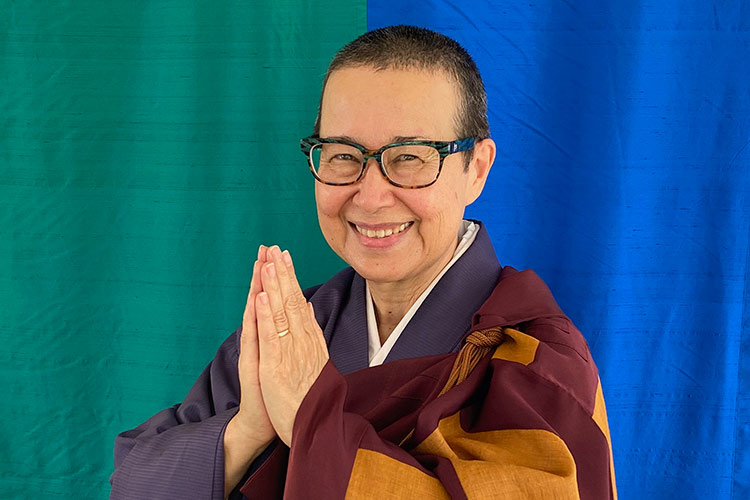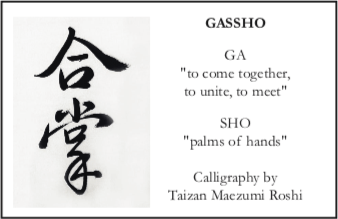
Musing on Living in Gassho
October 1, 2020
The circumstances of these days are relentlessly calling each of us to an awakening. How are you meeting this moment? There is a koan that states: “One hand before the fifteenth day, one hand after the fifteenth day. One hand on just the fifteenth day.” This koan is the perfect expression of gassho, the theme of the Fall Practice Period. Gassho embodies inter-being.

During these Pandemic days, the realization that we inter-are, to use the word coined by the Ven. Thich Nhat Hanh, is not difficult to see. Our challenge is to act in a way that is in alignment with this realization.
When you bring your two hands together in front of your body, right here is the “15th day.” The fifteenth day is the day of the full moon, which is the Buddhist metaphor for complete, unsurpassable enlightenment. Right here is the bringing together of mind-created opposites (which is the only kind of opposites there is). This includes the so called opposites of Buddhas and Beings, BIPOC (Black, Indigenous, People of Color), and White people, worthy and unworthy, deserving and undeserving, and so on. When you make gassho, you personify the state of no gap between you and everything else, without exception.
Although some of you may live alone, the present circumstances have made it clear that we, in fact, don’t live our lives alone—we live together, intricately and intimately bound, in a vast and varied human community. Western society places far too much emphasis on being a separate individual. The Pandemic, Black Lives Matter, and the climate crisis each, through its own particular lens, points to the fact to which Shakyamuni Buddha awakened: that you have never been an individual separate from all that is. You have never been separate from, better than or less than, anything or anyone that is different from you. This realization cuts through the invisible and not so invisible constructs and systems of privilege and race, skin color and class designations, wealth and poverty and so on.
You have never been an individual separate from all that is.
“Ga” means “to unite or come together” and “sho” means “the palm of your hands.” Although there are variations of how the hands are placed together, gassho expresses the unified heart-mind, specifically the fundamental unity of Buddhas and Beings. To bring yourself into gassho signifies that you recognize that every person and every thing, without exception, is intrinsically buddha nature. The mind can easily find itself in the distorted view that since everything is buddha nature, then everything is the same and differences are somehow diminished. This lopsided sentiment is a variation of people saying, “We emphasize our differences too much. Let’s focus on what we have in common.” Buddhism provides an alternative for this distorted thinking.
What gassho is actually expressing is that everything is both uniquely and equally different and unified as one undivided life. Can you keep the equality of differences—the uniqueness of each person or thing—and realize it all together as unified life itself, without distorting it by valuing some differences more than others? Conventional wisdom, if we can call it wisdom, says that differences are a problem and the way to deal with them is to erase differ- ences and emphasize the sameness. It is like the pernicious assumption that “all lives matter” and fail to see that Black Lives Matter. Each finger of the gassho is a unique dharma— do not ignore the dignity of differences.
These days the old paradigms are shifting. Awakening is the biggest paradigm shift of all. As Zen practitioners, we learn that an awake life honors equality of differences as the life of the Buddhas. The intersections of the Pandemic and the exposure of white privilege and racial injustices has torn away the veils of a caste system that values white bodies over BIPOC bodies. As a BIPOC person, I gassho to white people who are doing the deep forensic inner work of dissecting the unearned privileges that come with having white skin. I gassho to those who translate their realizations from this work into actions that dismantle systems of racism, white privilege, and all inequalities that keep a life of justice and respect out of reach. Let’s shift the paradigms of our personal and societal karma to erase white supremacy forever.
These days the old paradigms are shifting. Awakening is the biggest paradigm shift of all.
The one-hand koan quoted above points to three important aspects of the process of transformation. “One hand before the fifteenth day” calls you to look at the past and learn what you can from it. Many people today are learning about the actual events and experiences of Black lives. This is not about wallowing in shame and guilt, but a deep learning of what caused harm and suffering. “One hand after the fifteenth day” calls you to envision a world that is beneficial and life-affirming for everyone. And “one hand on just the fifteenth day” is you, right now, waking up to and carrying out the actions that affirm a life of renewal and purposeful revisioning of equal justice for all.
Transformation may seem like a very big leap, but when you gassho, you recognize your place in the world. Embodying the fact of life’s interdependence and the true nature of differences, you will feel compelled to use your uniqueness, your wisdom and compassion, to leave behind a life of isolation and dismantle systems of separation and oppression. Martin Luther King, Jr., powerfully expressed this in his “Letter from the Birmingham Jail.” He wrote:
I am cognizant of the interrelatedness of all communities and states. I cannot sit idly by in Atlanta and not be concerned about what happens in Birmingham. Injustice anywhere is a threat to justice everywhere. We are caught in an inescapable network of mutuality, tied in a single garment of destiny. Whatever affects one directly affects all indirectly. Never again can we afford to live with the narrow, provincial “outside agitator” idea.
This is the meaning of placing your palms together.
The gassho that you make with your palms pressed together with no gap between the palms is called the “mother gassho.” It is said that all the buddhas arise from the mother gassho. This means that when you place your palms together, this act of at-one-ment embodies the quality of renewal. In each moment, you can renew yourself. The heart-mind (nen) of this moment is renewed. You can shift your mindset, adopt a new habit, adopt a new way of thinking or a new way of seeing. You can rewrite your own life narrative so that it is life-affirming, no matter how dire your circumstances.
It is said that all the buddhas arise from the mother gassho.
When you make gassho, you are affirming that your default position is to align yourself with the wholeness of life—not your idea of oneness, but actually seeing in detail how all life supports your existence. For example, when you eat a meal, you viscerally connect with how the meal came to you—the sun and rain, the earth and its nutrients, the seeds and the farmers, all that supports the life of a farmer, all that supports the life of those in the supply chain, the grocery store, the delivery persons, and how it arrives in your hands and into your mouth. This is not an intellectual exercise!
Give thanks, express gratitude, place your hands in gassho and affirm this web of life that is activated for a simple meal. For everything you wear—sit on, clean your house with, water, electricity—lean into the specificity of how it comes to you. Your life is completely dependent (not just interdependent) on everyone and everything else. Gassho is a simple yet profound gesture of alignment to this reality.
What causes the gap? How can you close the gaps? Arouse curiosity! Recognize the reference points of self-righteousness. Shift your personal paradigms just as the paradigms of the world are shifting under your feet. Be open. Try new ways of being as you explore gassho. As Maezumi Roshi often said to us, “Have good guts!”
Roshi Egyoku is the Head Teacher and Abbot Emeritus of ZCLA.
